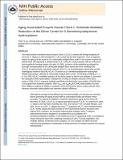| dc.contributor.author | Lu, Tsai-Te | |
| dc.contributor.author | Lee, Seung Jae | |
| dc.contributor.author | Apfel, Ulf-Peter | |
| dc.contributor.author | Lippard, Stephen J. | |
| dc.date.accessioned | 2015-02-24T20:03:59Z | |
| dc.date.available | 2015-02-24T20:03:59Z | |
| dc.date.issued | 2013-02 | |
| dc.date.submitted | 2013-02 | |
| dc.identifier.issn | 0006-2960 | |
| dc.identifier.issn | 1520-4995 | |
| dc.identifier.uri | http://hdl.handle.net/1721.1/95488 | |
| dc.description.abstract | The mitochondrial membrane-bound enzyme Clock-1 (CLK-1) extends the average longevity of mice and Caenorhabditis elegans, as demonstrated for Δclk-1 constructs for both organisms. Such an apparent impact on aging and the presence of a carboxylate-bridged diiron center in the enzyme inspired this work. We expressed a soluble human CLK-1 (hCLK-1) fusion protein with an N-terminal immunoglobulin binding domain of protein G (GB1). Inclusion of the solubility tag allowed for thorough characterization of the carboxylate-bridged diiron active site of the resulting GB1-hCLK-1 by spectroscopic and kinetic methods. Both UV–visible and Mössbauer experiments provide unambiguous evidence that GB1-hCLK-1 functions as a 5-demethoxyubiquinone-hydroxylase, utilizing its carboxylate-bridged diiron center. The binding of DMQ[subscript n] (n = 0 or 2) to GB1-hCLK-1 mediates reduction of the diiron center by nicotinamide adenine dinucleotide (NADH) and initiates O[subscript 2] activation for subsequent DMQ hydroxylation. Deployment of DMQ to mediate reduction of the diiron center in GB1-hCLK-1 improves substrate specificity and diminishes consumption of NADH that is uncoupled from substrate oxidation. Both V[subscript max] and [k[subscript cat] over K[subscript M]] for DMQ hydroxylation increase when DMQ[subscript 0] is replaced by DMQ[subscript 2] as the substrate, which demonstrates that an isoprenoid side chain enhances enzymatic hydroxylation and improves catalytic efficiency. | en_US |
| dc.description.sponsorship | National Institute of General Medical Sciences (U.S.) (Grant GM032134) | en_US |
| dc.description.sponsorship | National Science Council (China). Postdoctoral Research Abroad Program | en_US |
| dc.description.sponsorship | Alexander von Humboldt-Stiftung (Fellowship) | en_US |
| dc.language.iso | en_US | |
| dc.publisher | American Chemical Society (ACS) | en_US |
| dc.relation.isversionof | http://dx.doi.org/10.1021/bi301674p | en_US |
| dc.rights | Article is made available in accordance with the publisher's policy and may be subject to US copyright law. Please refer to the publisher's site for terms of use. | en_US |
| dc.source | PMC | en_US |
| dc.title | Aging-Associated Enzyme Human Clock-1: Substrate-Mediated Reduction of the Diiron Center for 5-Demethoxyubiquinone Hydroxylation | en_US |
| dc.type | Article | en_US |
| dc.identifier.citation | Lu, Tsai-Te, Seung Jae Lee, Ulf-Peter Apfel, and Stephen J. Lippard. “Aging-Associated Enzyme Human Clock-1: Substrate-Mediated Reduction of the Diiron Center for 5-Demethoxyubiquinone Hydroxylation.” Biochemistry 52, no. 13 (April 2, 2013): 2236–2244. | en_US |
| dc.contributor.department | Massachusetts Institute of Technology. Department of Chemistry | en_US |
| dc.contributor.mitauthor | Lippard, Stephen J. | en_US |
| dc.contributor.mitauthor | Lu, Tsai-Te | en_US |
| dc.contributor.mitauthor | Apfel, Ulf-Peter | en_US |
| dc.contributor.mitauthor | Lee, Seung Jae | en_US |
| dc.relation.journal | Biochemistry | en_US |
| dc.eprint.version | Author's final manuscript | en_US |
| dc.type.uri | http://purl.org/eprint/type/JournalArticle | en_US |
| eprint.status | http://purl.org/eprint/status/PeerReviewed | en_US |
| dspace.orderedauthors | Lu, Tsai-Te; Lee, Seung Jae; Apfel, Ulf-Peter; Lippard, Stephen J. | en_US |
| dc.identifier.orcid | https://orcid.org/0000-0002-2693-4982 | |
| dc.identifier.orcid | https://orcid.org/0000-0002-1577-2420 | |
| mit.license | PUBLISHER_POLICY | en_US |
| mit.metadata.status | Complete | |
